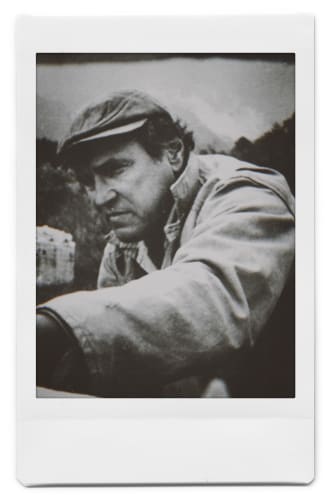After studying architecture at the University of Montevideo for 3 years, Fonseca left to join the painting studio of modernist Joaquín Torres-García and his students during the 1940s.[4] Here, Fonseca practiced painting under professional instruction for the first time. While studying under Torres-García, Fonseca’s interest in geometry peaked and serves as Torres-García’s largest influence on him. The two artists became close and their friendship lasted until Torres-García’s death in 1949. After leaving Torres-Garcia’s studio, Fonseca traveled extensively throughout Egypt, the Middle East, and took residence in Paris, Rome, and Madrid.[5] While travelling, Fonseca explored ideas of regional identity and place. He thought to be truly cosmopolitan, or universal, one must act more as a resident than as a patriot. Fonseca deeply considered this concept and began to view nationalistic identities as restrictive and oftentimes, perpetuated false stereotypes.[6] While in Europe, Fonseca traded painting for sculpture, hoping to fully develop his artistic style. Through his sculptures, he aimed not to attract viewers to a landscape but to embed the landscape within them.[7]
In 1958, Fonseca moved to New York City and from that point on, split his time between there and Italy.[8]
A lifelong scholar, Fonseca took pride in being well-read. He prioritized learning as much as possible about humans, civilization, and history always searching for a universal truth to be expressed through his art. He became fluent in 8 languages and provided illustrations for authors such as Jorge Luis Borges, Rainer Maria Rilke, and Michel de Montaigne.[9] His works have been shown in institutions all over the world including the Jewish Museum in New York, The Portland Museum, MoMA, Museo Bellas Artes (Caracas), and the Gallery San Marco (Rome, Italy). In 1990, Fonseca represented Uruguay in the 44th Venice Biennale and was honored with a retrospective by the Noguchi Museum in 2017.
Fonseca’s works can be found amongst a number of institutional collections including: Jack Blanton Museum (University of Texas), Museo de Bellas Artes (Caracas), Solomon R. Guggenheim Museum (New York), The Brooklyn Museum of Art, Portland Art Museum, Museo Municipale (Italy), Museum of Fine Arts (Houston), and the Instituto Valenciano de Arte Moderno (Valencia, Spain).[10]
